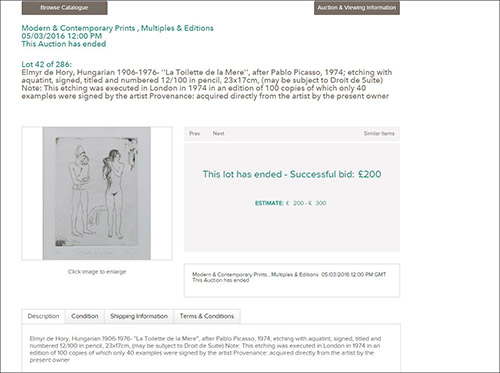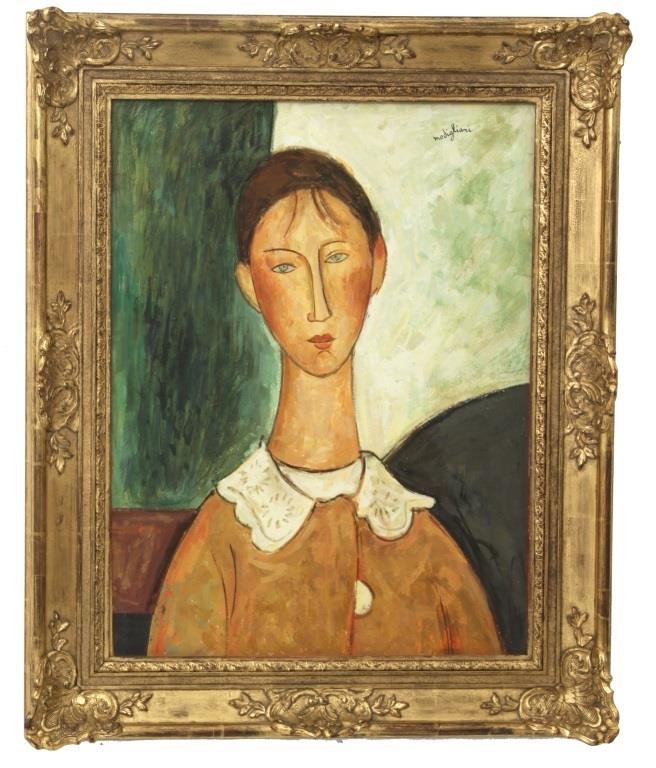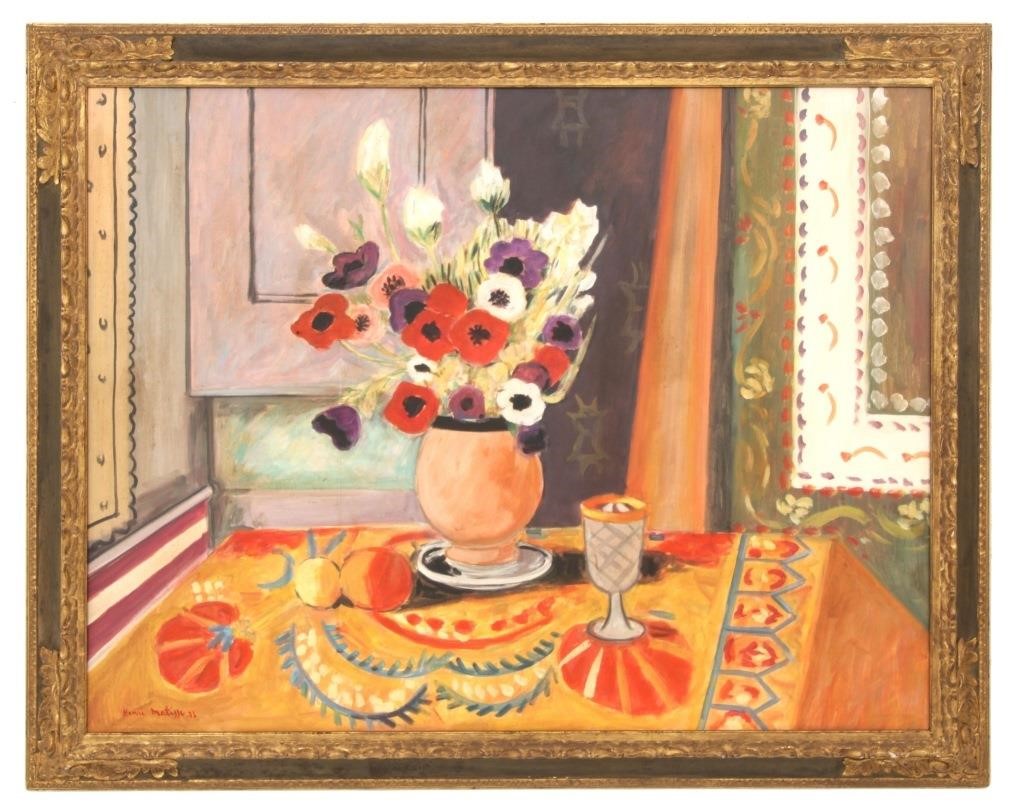The buyer-beware principle of the marketplace is commonly overlooked in the feeding frenzy of auction house bidding. There is also an assumption of integrity invested in these purveyors of art, collectables, or anything on which a profit can be made. Read the terms and conditions of an auction house catalog. You’ll see how they distance themselves from assuming any liability or guarantee of authenticity. Prospective buyers or sellers too often confuse “valuation” with “authentication.” Simply because an item may be consigned to be sold and a guesstimate of value assigned that item the question of authenticity is an issue between the buyer and seller. It conveniently exonerates the auction house from culpability and, most importantly, does not interfere with the business of making money. Their obligations to protect consumers’ interests are limited by design.
I have had some success in interdicting bogus Elmyrs in auction sales – and sometimes my protestations have been ignored, as in this recent sale of a print in the manner of Picasso purportedly by Elmyr. In this case the auction house elected to believe the seller’s allegation that this print was “acquired directly from the artist by the present owner.”
Although I discredited the authorship of this print and the owner’s alleged link to Elmyr, the auction house allowed the sale to proceed. Establishing a sales history at public auctions is a pathway forgers and fakers use frequently to perpetrate art fraud. Auction houses have a lamentable record of complicity in enabling art crime. Their inability, or unwillingness to better police their own business practices that allow “plausible deniabilty” are loopholes fraudsters use with alacrity. This may well be why Elmyr and others of his ilk are remorseless about their crimes. They simply are playing by the rules of marketplace, one that resists accountability and thereby remedying a problem, which, in part, is their own creation. So, the burden of guilt can be shared. This reality also accounts for the lack of outrage I feel about Elmyr’s guilt and why I view him more of a player in a duplicitous world of art where hucksterism – and irony, are ever present.
This wretched work attributed to Elmyr has appeared numerous times for sale on eBay over my consistent objections about its misattribution and my complaints to the seller. It demonstrates the ineffectual measures and lack of due diligence online – or traditional auction houses take to protect consumers from fraud. While the irony of defending an art forger’s authenticity is never lost on me, it shows how Elmyr and others of his ilk, profit from a poorly regulated marketplace – to their advantage. As long the free-marketeers’ mantra of ‘let the market decide’ holds sway, self-interest and profit-taking will always prevail over consumer protection. In light of this reality, I still view these fraudsters as players in a system tilted in favor of profiteers. Quel surprise.
August 17, 2019
More examples from the cottage industry that fabricated phony Elmyrs after his death in 1976. They continue to pollute the art market, most commonly in online auctions where due diligence in establishing a verifiable provenance remains a serious problem. The irony of faking a faker is obvious. Lamentably, the exploitive nature of the marketplace has not changed at all since the halcyon days of Elmyr’s fakery. Self-interest and the push for deregulation (code for unaccountability), allow profiteering on both sides of the legal divide – an unlearned lesson from Elmyr’s saga. So, when the guardrails for consumer protection are discarded, marketplace morals are predictably low. This atmosphere creates a hothouse for unethical or illegal activity in which fraudsters thrive.
On another note, and where I share the scholars’ objections to fakery, is that it distorts the historical record of an artist’s work. However, Elmyr always asked: “Would you prefer a bad original to a good fake?” This goes to the heart of how we see and value art. The question is still valid. His advice to me rings true today – “Never buy art for the price tag or signature attached.”
My principal problem with the would-be Elmyrs is not their distortion of market value as much as debasing the technical virtuosity of his artistic skills whether intended to deceive or not. Most of the visual flotsam passed off as products of de Hory’s, are of little merit. And, I suspect, these imitators think ‘faking fakes’ is low on the sin list.The following email thread pertains to the three above works that were subsequently sold in public auction by Fontaines gallery on September 14th, 2019:
From: Mark ForgyDate: August 18, 2019 at 6:03:19 PM CDTTo:info@fontainesauction.comSubject:Re: Regarding de HoryJohn:
This is most bizarre exchange I’ve had with an auction house – and I’ve had many regarding phony Elmyrs. Your decision to keep or reject these similar works needn’t be so ponderous or strive for the gravitas your response tries to impart.
I am the SOLE authority on Elmyr’s art. Auction houses use me as an ‘expert’ to authenticate his work. Yet my expertise, role as his personal secretary, archivist, curator, sole heir, manager of his estate, licensor of his images and oeuvre, owner of the largest private collection of his art, having lived with and worked for him the last seven years of his life, and chronicled that in my book The Forger’s Apprentice: Life with the World’s Most Notorious Artist, besides arming you with the testimony of José Luis Branger regarding Joël Roger – somehow begs further examination in this dispute. Remarkable AND laughable.
I appreciate the careful and weighty decision making you bring to your business and eagerly await your epiphany.
Mark Forgy
On Aug 18, 2019, at 9:00 AM, info <info@fontainesauction.com> wrote:
Mark, I am in the last stages of the due diligence which I afford top every consignor & buyer I do business with. Once my inquiry is complete & I’m able to establish whether the artwork is authentic or not, I will make the determination whether or not to withdraw the paintings in question. I will keep you informed. – John
John FontaineFontaine’s Auction Gallery1485 W. Housatonic St., Pittsfield, MA 01201Phone: 413-448-8922 Fax: 413-442-1550info@fontainesauction.com
—–Original Message—–From: Mark ForgySent: Thursday, August 15, 2019 3:37 PMTo: info <info@fontainesauction.com>
Subject: Regarding de Hory
John:
Your response to my last email is not what I have encountered from responsible auction houses in similar circumstances. In the face of all the pertinent details discrediting the bogus Elmyrs you are offering, you seem to be comfortable with your client’s disposition as a sort of ‘last court of appeal’ – deferring to his credibility, not mine. It’s an unusual abdication of an auction house director’s fiduciary obligations to protect the public interest.
I trust you understand that, since I’ve been enforcing the authenticity of Elmyr’s work for four decades, I will take action against the sale of fraudulent Elmyr works, like the ones you are representing as true sales. Do not let your client convince you into committing a criminal act – the consequences will be borne entirely by you, and trust me, it’s not worth the trouble that will follow this action.
I am currently collaborating with a documentary maker on this phenomenon of fake Elmyrs and marketplace morals. The business practices of auction houses are a central theme.
Mark Forgy




